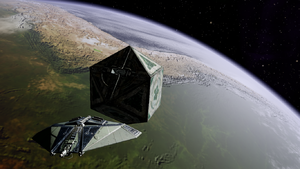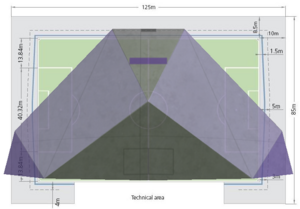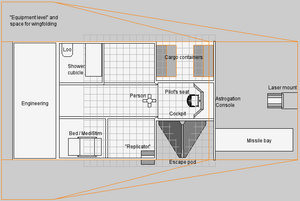Distance (Oolite)
Distances in Oolite can be problematic.
The two short rules of thumb are: (1) ships are very much oversized, and everything else is very much undersized; and (2) none of the sizes makes sense in relation to human size.
- If you work out the size of your Cobra Mk.III (130m×30m×65m), it is as big as a football field (105mx68m)!
- According to the lore, thousands of ships can fit into an Orbital Station (1km³).
- This station hovers some 40-60 km over the surface of the planet (while in reality, the International Space Station hovers some 400km over the earth).
- The planet is a mere 1,000 km from the star (while the sun is 150 million km from the earth).
Why?
Playability trumps realism in the Vanilla game:
Ahruman: All the ships in Oolite are ridiculously large, even when you don’t take the tiny planets into account. Weren’t they at some stage converted from N ft to N m instead of 0.3048N m? If so, the sizes on feet were merely surprising, not silly. :-p Aegidian: Agreeing here! The adjustment from feet to meters was necessitated by the increase in scale of the space station to it's full 1km diameter glory. If the ships had stayed scaled by feet then they'd almost all fit in the docking slit sideways - and docking is such an important part of the (original Classic Elite) experience that it was necessary to scale ships to match. The Cobra 3 is particularly huge! (Aegidian, Feb 2006)
There are five possible solutions.
1) Ignore the discrepancies and focus on enjoying the game.
| First of all, remember that Oolite is a game, not a space simulation. This is because it wants to be a game, not a sim. So yes, sizes and distances are all messed up. Ships and stations are too big, planets and suns are too small, and too close to each other. But this is deliberately so, and we are not going to change it. The reason is simple: Realistic sizes and distances don't make a good game. In reality space is so huge that you never would meet anybody else on your journey. Imagine the dozen or so ships you meet in the 500 or so kilometers between witchpoint and planet spread over the realistic 150 million kilometers between Sun and Earth. Even if your direction is only one degree off the perfect line, you would miss them all. And how interesting would that be for the gameplay? And finally, if you had a realistically sized station in front of a realistically sized planet, how would you ever even notice it? A grain of sand in front of a, well, planet. The result would be players in complete loneliness and virtually no interaction with NPCs. An utterly, utterly boring game. Therefore it was the right decision to screw realism in the layout of the planetary systems in Elite and Oolite. |
| (Oolite FAQ) |
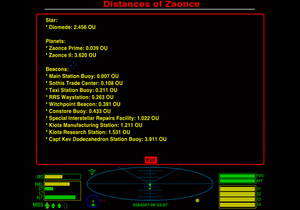
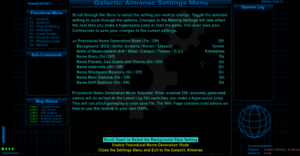
2) Abandon the kilometre.
Use Astronomical Units (OU's) instead (some OXPs facilitate this: Strangers World, Navigation MFD, etc).
Or adopt Byzantine plethrons or Venetian cavezzi! The Galactic Almanac OXZ allows a choice of units in both its F4 screen database and its MFD - as does the Navigation Beacons MFD
3) Redefine the kilometre.
| Ah, the km, pronounced koom (kuː ʊm) of course! An ancient unit the origins of which are long since lost. Legends tell of prehistoric origins, early scientists trying to express distance in terms of wavelengths of light and indeed some planets, most notably Teceinre, have a celebration to honour the legend which consists of pacing up and down in period costume, holding glass balls (representing ancient light sources) and using a so called "foot rule" and eyeglass to admire the wavelengths whilst reciting poetry. Claims that this was started by Teceinre marketeers as a way of selling more of their poetry have consistently been denied. The ludicrous fractions and ratios needed to shoehorn this theory into accepted history or science are however simply not credible and most leading historians hold that it was once defined as a multiple of the average step length of aristos in Old Paris. Sadly through various reformations, rationalisations and standardisation efforts it no longer bears any meaningful relation to its origins and now used mostly by spacers as an indicator of distance generally taken to be the distance a ship would travel in one second when travelling at 0.001 LM or, less formally, half the distance a typical spacer can throw an Ou fruit at standard Isqueder gravity after a few glasses of Tibediedian Arma brandy. |
| (Commander James 2020) |
4) OXPs
There are a number of OXPs which move the sun further away from the planet. See Guide to Ambience OXPs.
5) Join the Rescaling experiment which is trying to solve this issue.
You will notice that all the solutions are partial. The Rescaling experiment is probably the best bet to sort it all out (or at least most of it!).
Links (a small selection)
- BB Discussion thread 2020 - general
- BB Discussion thread 2016 - see Norby's concluding post
- BB Discussion thread 2013 - general
- BB Discussion thread 2013 - fitting cargo in ships
- BB Pithy Post 2012 - Commander McLane
- BB Discussion thread 2011 - what is 1TC of cargo?
- BB Discussion thread 2010 - ship dimensions
- BB Discussion thread 2009 - fitting pilots in ships
- BB Discussion thread 2008 - general
- BB Discussion thread 2008/9 A step towards solving the f*&%§d-up distances conunundrum (has a good analysis of the problem).
- Going the long way (2009) See Daddyhoggy's overnight exploits on C64 Elite
- BB Rescaling Discussion thread 2013-date
- Guide to Ambience OXPs - compares the OXPs which tweak the sun-planet distances
- Rescaling experiment
- Jane's Galactic Shipset - rescales the Shipset of the Vanilla game, based on Classic Elite sources
- Selezen on spacecraft scales with links to a discussion thread (2011)
- Light Mach - this unit has similar issues!
- Time - and there are issues here too!
